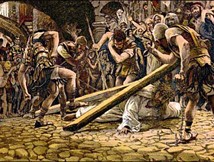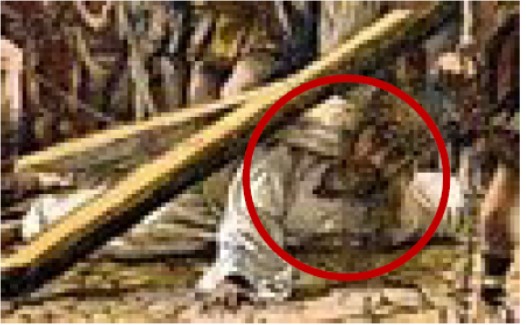2.1 The Father Plainly
In this chapter and the next we continue to set the ground-work for how we are to know the definition of the human.
This groundwork is critical for two reasons. First, the definitions of the human held by all mankind, Christians and non-Christians alike, are so contrary to reality and so ruinous that our escape was life instead of death. And second, the glory of being, as we are, the likeness and revelation of the Father, is so wondrous and so complete and real that, to know it, we must stand upon a firm foundation.
In short, the passageway from one mind to the other mind is the meaning of redemption and the greatest miracle that any of us ever experienced.
Looking with Purpose. The title of this chapter is “What Did Jesus See?” This question is based on Hebrews 12:2. – Looking with purpose into Jesus, the source and the completion of our faith, who, looking instead at the joy and delight set before Him [the Church] endured the cross…
As Jesus walked the path of the Atonement He saw His prize, the joy and delight set before Him. What He saw made Him willing to endure every contradiction of sinners against Him. Yet this line also contains the great riddle of God, that we cannot know what Jesus saw unless we first know what we see as we are “looking with purpose into Jesus.” In the next lesson we will consider what Jesus saw, but first we must know what we see in this Man walking this path.
A Strange Riddle. Nowhere is God’s great riddle, that He calls the mystery of Christ but that we sometimes call the Jesus Secret, more importantly described, as well as more ambiguous and easy to miss, than in John 16:25.
These things I have spoken to you as allegories [metaphors – figurative language]; the time is come when I will speak no more in metaphors, but concerning the Father I will report boldly and publicly to you.
Basically, Jesus was stating that everything we knew about God prior to that moment was figurative only, an attempt to express God’s realities inside of limited human understanding. Several minutes later Jesus stopped talking and never said anything more about the Father to His disciples.
Plain Reporting. What does this riddle mean? If Jesus’ talking had been figurative only, what was now this “plain reporting?” You see, He said, “The time is come,” not “the time will come someday.” Only an hour or so earlier, Jesus had already given His disciples the full answer to this riddle. – He who has seen Me has seen the Father (John 14:9).
Jesus’ “bold and public report” of the actuality of God, who God is, what He looks like, and what He does inside His creation, was nothing other than Jesus Himself, walking the path of the Atonement from Gethsemane to the resurrection.
The most important decision of your life is deciding what it is you see when you look into this Man walking this path.
What Do You See? Looking with purpose into Jesus. Look at this man, at his lowest point, pinned to the ground under a cross he cannot carry. What do you see?

I see God. I see the clearest, boldest, most public and plain actuality of God the Father ever given inside of creation, inside all heaven and earth. Yet most Christians do not see God in this man; rather, they see ‘God’ in the Roman soldiers punishing this man instead of us.
If this man is reporting to us the Father plainly, then what is God? And what does God do?
Image as a Focusing Lens. I will report, concerning the Father, boldly and publicly.
It is clearly God’s intention for us to define God the Father through this very human man, generally through his entire life, specifically through His walk of Atonement, but mostly through this picture of Jesus at his lowest point. “Carry your cross,” He had told His disciples, yet the Christ of God could not carry His own.
Let me explain what God means. – God means image. We look through this image, as a lens focusing for us what it is we see, in order to know the Father plainly. Yet this image is a man on his face in the dirt under a cross he cannot carry. – He who sees Me sees the Father.
Two Simple Definitions. I have written this last bit as if you are considering this most glorious truth for the first time. Since you have already made your decision that we know God only through the image of Jesus, we will switch tone and continue with the simple definitions Jesus’ report gives us.
We know ourselves, what it is to be human, only through first knowing the Father, and we know the Father only by looking through this Man. – Looking with purpose into Jesus. 1. God reveals Himself through human weakness and limitation; human weakness shows us God. 2. The action of God, upon entering visibly into His creation, is to humble Himself.
Inside the Circle. What is that inside the circle?

1. Every Word God speaks, the all-speaking of God, now become flesh.
2. The all-now Sustainer in power of everything that exists in creation.
3. The shining forth of glory and the character and exact reproduction of God’s substance.
4. The becoming of all, the becoming of the entire cosmos.
5. The actual and active life force of every human being.
6. The full cleansing away of all falling short.
7. The highest and most exalted meaning inside of God’s reality.
Where Are You? Those are seven wondrous reports, seven God-things, but they are not the most important thing we see inside that circle. The most important thing for you and me inside that circle is us, carried inside of Jesus, carried inside His Heart. Looking with purpose into Jesus – and seeing ourselves safely there. Yet in being there, we are also safely inside of all seven of those wondrous Reports of God.
You ARE inside of that Man. You are inside of every Word God speaks, inside of all sustaining power, inside of the character of God’s substance, inside of the becoming of all, inside of the life force of every human being, inside of the cleansing away of all falling short, inside His exalted name.
A Way. You are inside of a man on his face in the dirt under a cross he cannot carry, carrying you, carried by Father through a way neither Jesus nor you could ever go, all the way through death and into life. This is the definition of God. It is also the definition of man. The All-Carrying One, a God who carries all. Surely He has borne our griefs and carried our sorrows.
Now, this Way is first practical and real, the concrete reality of Blood in the dirt of the earth. Yet as such – It is finished. For us now, however, the Way takes a different form, it is a Way from a false way of thinking about our humanity to knowing ourselves as God knows us.
The Way as Story. Let’s take a slightly different approach, now, to this Report that boldly and publicly demonstrates God our Father. As we have just noted, although this picture is of one moment in Jesus’ life, it is part of an ongoing action “script,” we might say. That is, it is one moment in an entire story that shows us God.
I am the Way, the Truth, and the Life… to know Me is to know the Father (John 14:6-7 – partly paraphrased.) Let’s define a “way.” A way is a path one must traverse, that is, journey upon. That way then has a starting point and it has an ending point. It is, in effect, the plot of a story. And so the word “Story” is just the best term for us to use to understand this bold and public Report of God-as-He-is.
The Story God Is Telling. Remember that the guiding idea of this course is that Jesus is the pattern by which we humans are designed and formed. So, when Jesus presented Himself as the image of the Father, He began with, “I am the Way.” – “I am the Story God is telling to all about Himself.”
When we say that the human soul is a story of words inside of a spirit self-awareness, we are not speaking of words as formulas or as philosophy. We are speaking of the words that come out from and repeat to us the story of our lives, all the experiences and interactions with others over years. For that reason, we know that this Way of the Atonement that Jesus walks before us, this Way into all the knowledge of God, informs us of what it means to be human.
The Story. The extraordinary thing is, then, that the great Story of God, the story of human life God is telling, follows all the great patterns of story used by human writers who seek to share with us a story of the human condition.
A hero leaves his home and journeys far. Along the way, he finds companions who support him, but who are often a silly distraction. He faces opposition along the way and enjoys times of refuge and rest. Then, he comes to the great climax of the story, when he faces the enemy to defeat him. That enemy, in whatever form the enemy takes, matches the hero such that the battle is to the edge, one might say, to a point of almost-defeat.
The Climax. That moment of almost-defeat is so critical to the purpose of story, for the purpose of story is to split the hero wide-open, figuratively speaking, so that all can see the core and meaning of that person inside his heart.
At the same time, in this moment of climax, the companions of the hero give their all for his sake and for victory. Also at the same time, the heart and purposes of the enemy are exposed for all to see as well – the lie and the curse. The end result of victory, then, is the kingdom restored.
This is the path Jesus walked, the purpose of His soul being “split-wide-open” upon the cross, for in seeing Him as He is, we see ourselves inside of Him and we see the Father as He IS!
The Jesus Secret. To know Jesus “split-wide-open,” then, we combine Psalm 22 with John 19, two different views of the same broken man, David’s view from the inside and John’s view from the outside. Psalm 22 shows us clearly the almost-defeat, the very edge of the precipice to which the revelation of God through Him placed the Lord Jesus Christ.
This great press, then, is for one purpose only, that we might know the Father and that we might know ourselves. This is the mystery of Christ; it is the Jesus Secret.
Jesus shows us the Father plainly through Himself, through the Way of the Atonement, and inside of Jesus, we find our human selves inside of this God.
